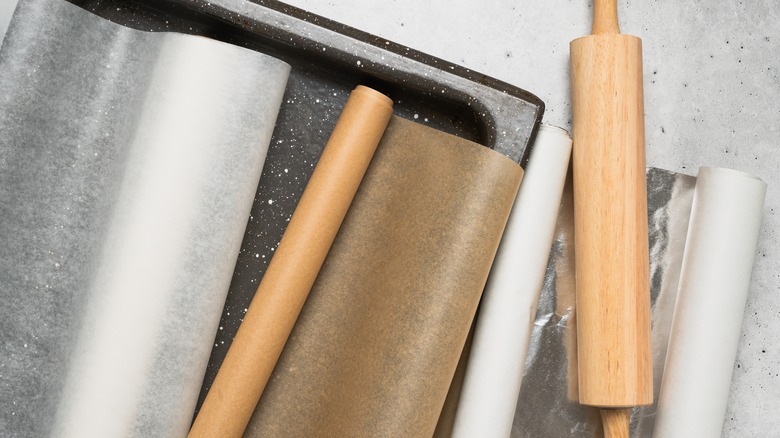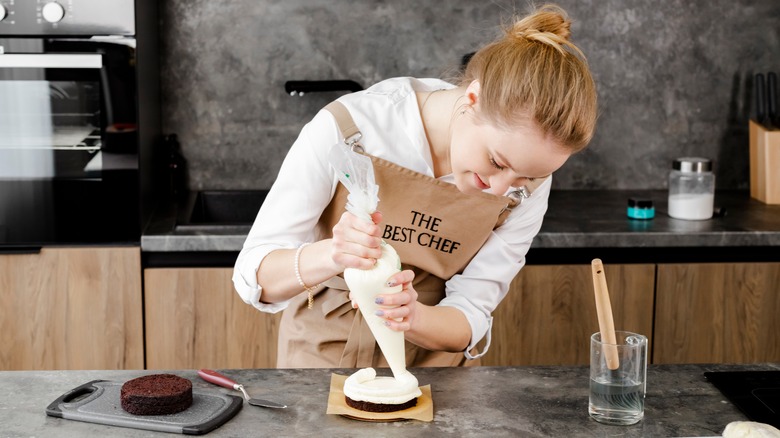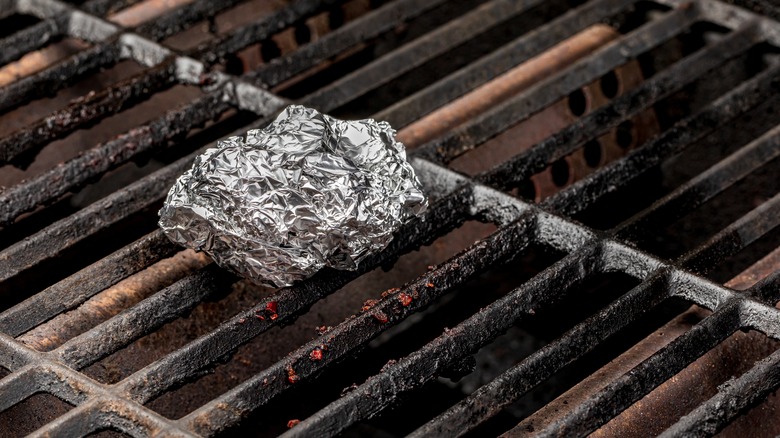No, Aluminum Foil And Parchment Paper Are Not Interchangeable
Two essential tools you'll find in most kitchens are aluminum foil and parchment paper. The former is made of a type of metal called alloyed aluminum and is housed in a thin, flexible sheet. In contrast, parchment paper is a silicone-coated paper. Both of these versatile cookware classics are heat-resistant and can be used for preparing food, lining pans or baking trays, and storing and preserving items. However, they are distinctly different and shouldn't necessarily be used interchangeably.
For example, aluminum foil cannot be used in microwaves, where it can cause sparks that are a fire hazard. But, when used with other cooking appliances, foil can withstand temperatures up to 400 degrees Fahrenheit. Parchment can be used across all cooking appliances, including microwaves, in temperatures up to 450 degrees Fahrenheit. This makes it the better bet for microwave heating, and cooking or baking at higher temperatures.
When it isn't greased, foil is more prone to sticking to food and tearing than parchment paper. So, if you need a non-stick cooking or baking surface, choose parchment paper because it is less likely to tear than foil and is naturally non-stick, even without grease.
Although parchment is great for lightly wrapping cooked or baked goods for storage, aluminum foil stands out as the best option when you need a moisture barrier because you can precisely shape it, and the metal completely blocks out all moisture, oxygen, and sunlight — perfect conditions for longer-term preservation in a freezer or safe sealing in a refrigerator.
Creative kitchen uses for parchment paper and aluminum foil
Both parchment paper and aluminum foil are incredibly versatile materials, and you can get pretty creative and inventive when putting them to use in your kitchen beyond just the typical uses. Parchment is particularly great for baking because of its non-stick factor. So, put a wide sheet on your kitchen countertop and use it as a surface to roll or knead sticky dough.
You can even use parchment paper for decorating your baked treats by funneling it into a piping cornet to ice cookies and cakes. Parchment paper can also be rolled into a funnel to move dry ingredients, like spices, back and forth.
It's a fantastic choice if you'd like to steam-cook a meal, like chicken, fish, or vegetables, but don't have or want to use a steamer. This French technique, called en papillote, or cooking in a pouch, uses parchment paper to gently steam your dish in the oven in a sauce or dressing.
Aluminum foil stands out as the best choice when you need a highly pliable cooking tool, however. Craft it into an improvised baking rack or a circle to keep batter or eggs in a round shape during the cooking process. Foil is also your best bet for caramelizing or crisping foods in the oven. When positioned beneath your food, foil's shiny surface reflects heat, speeding up cooking and encouraging browning.
Eco-friendly tips for using parchment paper and aluminum foil
Sometimes the most convenient kitchen tools can come with a sustainability impact, and parchment paper and aluminum foil are no exception. However, there are some steps you can take to be more eco-friendly with both items.
Aluminum foil is recyclable, as long as it is not contaminated with food waste. Give it a thorough rinse to clean off any residue and grease before tossing it in the recycling bin. If your foil is just too dirty for recycling, you can still put it to good use for cleaning your kitchen and skip the environmentally harmful chemicals. Roll it in a ball or shape it to accommodate tough-to-reach spots, and use it to polish silverware, clean grills, or scrub kitchenware that isn't prone to scuffing (however, avoid using a foil ball to clean delicate dishes with non-stick coatings).
Parchment paper unfortunately can't be recycled, but you can still make eco-smart choices when choosing your product. Unbleached parchment paper, often called brown parchment paper, is crafted from untreated wood pulp and is the more environmentally-friendly alternative to white parchment. It functions in much the same way, but skips the bleaching process, giving it a lower carbon footprint.



